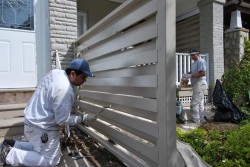How to protect your new fence for years to come?
 Fences are costly and it takes a lot of effort to install them; however, a beautiful fence can significantly increase the value of your property. For this reason, you need to do everything possible to maintain your new fence. To safeguard your fence against the weather elements like sun and the rain from ruining it, you could resort to staining or painting the wood. Below are some steps you could take to ensure your new fence lasts many years to come.
Fences are costly and it takes a lot of effort to install them; however, a beautiful fence can significantly increase the value of your property. For this reason, you need to do everything possible to maintain your new fence. To safeguard your fence against the weather elements like sun and the rain from ruining it, you could resort to staining or painting the wood. Below are some steps you could take to ensure your new fence lasts many years to come.
There are three common choices used to protect wooden fences from the elements of weather namely painting, semitransparent staining and solid staining. Painting a new fence for instance is a good way of covering its surface with a thin layer or film which prevents moisture from getting through to the wood. Moreover, paints offer UV protection to the underlying wood. Despite this, care must be taken to ensure paint is applied properly on the wood otherwise it will peel and expose the wood.
Just like paint, stains can also be used to protect a new fence. By staining your wood fence, the stain soaks the wood and fills the pores thus preventing water from reaching the interior. Semitransparent stain can also be applied although it has less pigment when compared to standard stains. Since it has got a translucent finish, the texture and the grain of the wood can be seen through the stain, which makes it appealing for new fences though it does not protect the wood from UV rays as much as solid stain or paint does.
Solid stains have more pigment when compared to semitransparent stains. As a result, it tends to cover the texture and grain. Therefore, you might find it to be an excellent choice for weathered or previously stained surfaces.
Just like a painting project, prior preparation of the surface ought to be done particularly if you want the paintwork to last many years. Painting a new fence is pretty straightforward. To prepare the surface adequately, you need to wash it with some water to remove any dirt or dust from the surface. However, if you are dealing with a previously painted fence, it would be best to sand off old paint with the help of a scraper and a heat gun; however, if you plan on repainting again soon, you can just scrape off loose or flaking paint.
You should also make a point of inspecting the fence on a regular basis while focusing on sections where posts are fixed into the ground. Such areas tend to encounter problems over time. Therefore carry out some occasional inspections and look for signs of trouble so that you can apply preventive measures early enough.
Overhang tree branches also need to be trimmed as they can cause extensive damage to your newly installed fence. Debris like fallen leaves also needs to be removed from the base of the fence otherwise they can cause moisture and mould build-up. Drainage is yet another aspect that needs to be looked into. Direct drainage away from the new fence posts to prevent rotting. Follow these simple guidelines and your fence will undoubtedly last a long time. For further information visit our Edinburgh Fencing home page and get in touch with our team.


